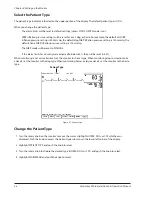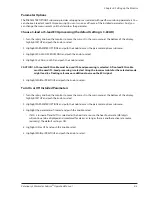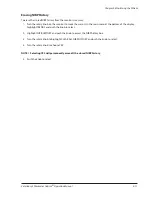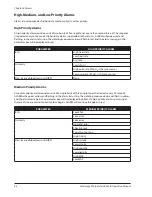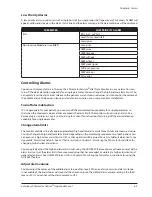
Chapter 5: Monitoring the Patient
5-2
Veterinary 3 Parameter Advisor
®
Operation Manual
Adjust the Parameter Box Settings
Turn the rotary knob on the monitor to move the cursor. Highlight the parameter box name and push the
•
knob to access the parameter menu in the lower left corner of the display. The settings available for the
selected parameter will be displayed.
Every parameter allows you to turn on or off its alarm detection capability in the parameter menu. For
•
example, if SPO
2
ALARMS is on, an alarm will be issued when the high or low alarm limit is violated. If
you turn SPO
2
ALARMS off and the high or low alarm limit is violated, an alarm will not be issued. See
Silence Alarms
in
Chapter 6: Alarms
for information regarding silencing alarms that are in progress, and
Select the Alarm Audio Silence Operation
in
Chapter 12: Service Menu
for information about silencing alarms
indefinitely.
For the parameters where more than one measurement can be monitored such as blood pressure
•
(systolic, diastolic, and mean), only one set of high and low limits can be displayed. You can specify in the
parameter menu which set of limits is displayed.
Refer to the chapters dedicated to each parameter for details regarding other pertinent settings.
Set the Alarm Limits
Set the high and low alarm limits for each parameter.
When a numeric measured value matches or exceeds the high or low limit set for that parameter, an
•
alarm is issued. For example, if the low alarm limit for SpO
2
is 85 and the patient’s measured value for
SpO
2
is 85 or less, an alarm will be issued.
The Advisor
•
®
Vital Signs Monitor provides clinically appropriate default high and low alarm limits for each
numeric measured value. You can choose different high and low limits, depending on the monitoring
requirements of each patient. For a list of default alarm limits, see
Appendix B: Alarm Limit Defaults
.
WARNING! Verify that alarm limits are clinically appropriate for your patient and adjust according to
institutional policy.
NOTE! Alarms may be tested while the monitor is in use by setting alarm limits such that the measured
value is outside the limits. Return the alarm limits to their clinically appropriate settings after
testing.
To set the high and low alarm limits:
Be sure that the sensor for each parameter is connected to the monitor, and where applicable, that the
1.
parameter or measured value is turned on using the SETUP menu and the PARAMETER OPTIONS submenu.
Turn the rotary knob on the monitor to move the cursor. On the main menu at the bottom of the display,
2.
highlight ALARMS and push the knob to select.
Highlight CHANGE CURRENT ALARM LIMITS and push the knob to access the alarm limit box.
3.
Highlight the name of each measured value and push the knob to select.
4.
Highlight the high alarm limit (HI) and push the knob to select.
5.
Turn the rotary knob to choose the desired value and push the knob to select. If you do not want a high
6.
alarm value, choose OFF. For example, the measured value for SpO
2
will not exceed 100 percent; select OFF
and no alarm will be issued for a high SpO
2
value.
Turn the rotary knob to highlight the low alarm limit (LO) and push the knob to select.
7.
Turn the rotary knob to choose the desired value and push the knob to select. If you do not want a low
8.
alarm value, choose OFF.
Содержание SurgiVet Advisor WWV9230
Страница 2: ......
Страница 10: ...Table of Contents viii Veterinary 3 Parameter Advisor Operation Manual This page is intentionally left blank ...
Страница 68: ...Chapter 7 ECG 7 14 Veterinary 3 Parameter Advisor Operation Manual This page is intentionally left blank ...
Страница 80: ...Chapter 8 Oximetry 8 12 Veterinary 3 Parameter Advisor Operation Manual This page is intentionally left blank ...
Страница 106: ...Chapter 12 Service Menu 12 8 Veterinary 3 Parameter Advisor Operation Manual This page is intentionally left blank ...
Страница 120: ...Appendix D Revision History D 2 Veterinary 3 Parameter Advisor Operation Manual This page is intentionally left blank ...
Страница 121: ......







